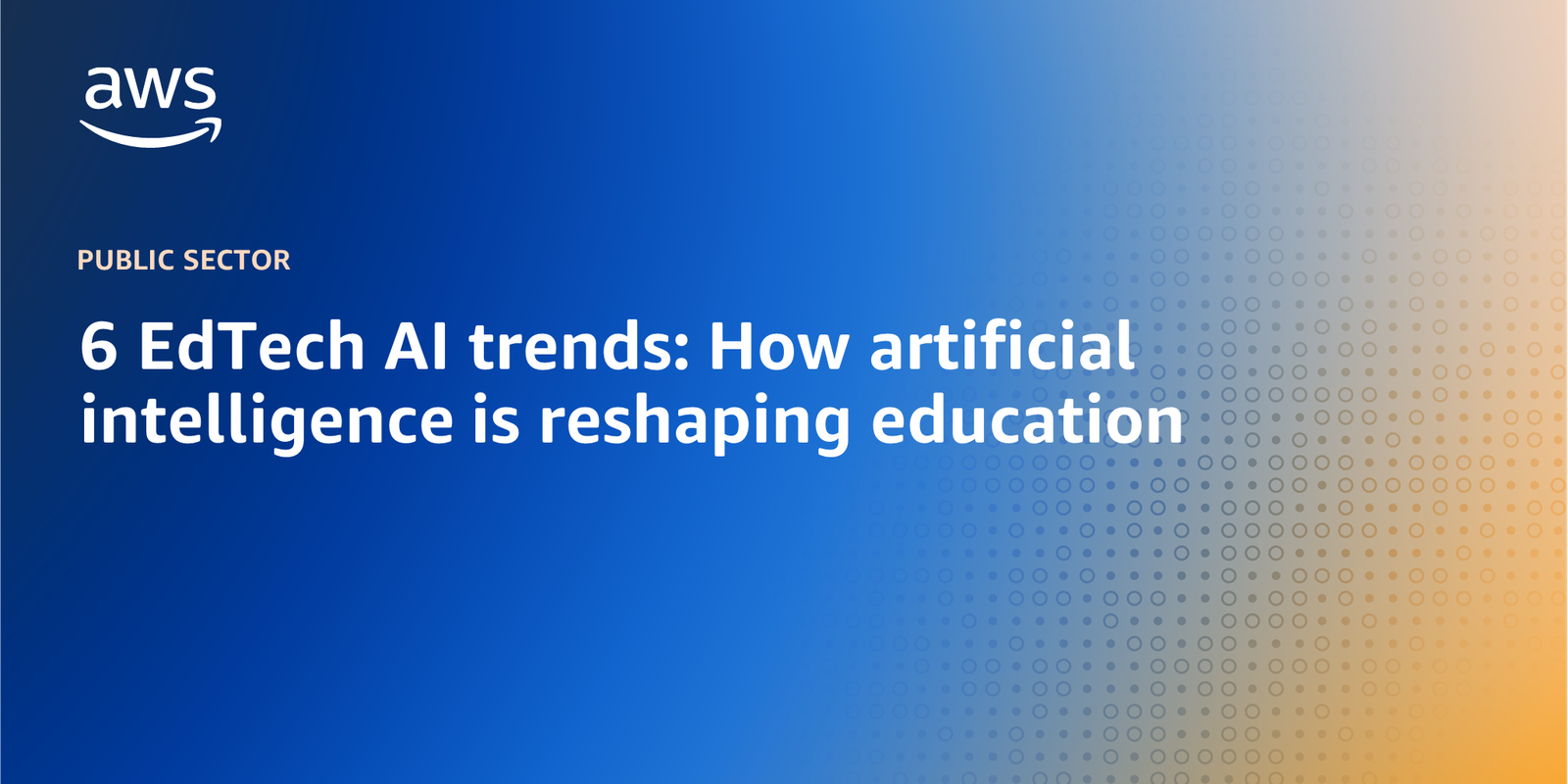Education
6 EdTech AI trends: How artificial intelligence is reshaping education

Innovation has always driven education technology (EdTech), and in 2025, artificial intelligence (AI) is leading the next wave. No longer just an emerging tool, AI is becoming the fundamental infrastructure shaping how EdTech evolves—reshaping how EdTechs develop solutions, how educators teach, and how students learn. It’s no longer a question of whether AI has a place in education, but how deeply embedded it will become.
At Amazon Web Services (AWS), we work with EdTechs of all sizes, giving us unique insight into how AI is shaping the industry. Based on our work with EdTechs and educational institutions around the world, we’ve identified six key trends shaping the future of AI in education.
1. AI is evolving from a tool to core infrastructure
A major shift is underway: AI is moving from being an add-on to an essential layer of EdTech infrastructure. AI is no longer just a feature; it is becoming the backbone of both EdTech products and internal operations.
EdTechs are embedding AI directly into their platforms to enhance learning experiences at scale. Instead of one-size-fits-all content, AI-driven solutions can analyze student assessments and dynamically tailor lesson plans to individual needs. This shift makes education more personalized, efficient, and effective.
At the same time, AI is optimizing how EdTechs operate. Companies are using AI to streamline business functions, from sales and marketing functions like forecasting, email marketing, and upselling, to finance, human resources (HR), and customer support. By automating routine tasks and surfacing actionable insights, AI allows teams to focus on product innovation and improving the customer experience.
The big takeaway for EdTechs? AI is no longer an option—it’s a necessity for staying competitive.
2. Educational institutions are adopting AI faster than expected
Historically, education has been cautious about adopting new technology. AI is proving to be the exception. Schools, colleges, and universities are integrating AI-powered solutions at an unprecedented pace. In a 2024 Ellucian survey of 445 faculty and administrators from across the US and Canada, 93 percent expect to expand their use of AI in their work over the next two years.
Unlike previous technologies that required extensive retraining, today’s AI tools integrate seamlessly into the workflows educators and students already use. Plus, as AI demonstrates immediate results and educators see real efficiency gains, this has led to higher comfort levels and faster adoption across institutions.
Trust has been another key factor in AI adoption among educators and institutions. EdTechs placed an early emphasis on responsible AI development, involving education institutions in shaping AI tools from the beginning to align with ethical standards, data privacy, and real-world classroom needs. This collaborative approach helped educators feel more comfortable with AI and accelerated adoption beyond what we’ve seen with previous technologies.
At the same time, alternative learning pathways like microcredentials and skills-based courses—such as those offered by Coursera and other platforms—are seeing rapid growth, particularly in AI and machine learning. In fact, 40 percent of Coursera’s top courses in 2024 teach AI, with three million new enrollments in generative AI courses during the year—one every 10 seconds. These programs highlight both the demand for accessible, flexible learning and the speed at which AI-related knowledge is being disseminated outside of traditional institutions.
3. AI is shifting from reactive to proactive support
One of the most significant changes we’re seeing is AI moving from reactive to proactive support models. Early AI systems waited for users to ask questions. In 2025, AI systems can understand context, anticipate needs, and offer support before anyone asks.
This shift makes truly personalized support possible at scale. For students, AI can now analyze assessment results and create customized learning paths targeting specific knowledge gaps. For example, Curriculum Associates uses AI on AWS to offer assessment programs that analyze results and deliver tailored content based on each student’s individual needs.
This evolution complements a broader shift in education platforms, moving from content-library models to more collaborative, student-centric environments. Modern learning management systems (LMS) like Schoology, Moodle, and Canvas increasingly support personalization, collaboration, and analytics. When combined with AI, these platforms can become even more adaptive and responsive to students’ learning preferences and progress.
For educators, AI is transforming administrative work. Benchmark Education’s AI-powered grading tool helps evaluate open-ended assessments, giving teachers valuable time to focus more on one-on-one instruction and student engagement.
With the development of AI agents, we are see more automation in education systems—where AI not only recommends but executes next steps, such as dynamically adjusting lesson plans or proactively suggesting interventions for struggling students before an educator even notices a gap.
4. Addressing education equity in an AI-powered world
AI has the power to transform education—but only if students have access to it. According to the Pew Research Center, internet access in the US has increased from 85 percent to 96 percent in the past decade. However, global access remains considerably lower. If AI-powered learning tools create superior educational experiences yet remain inaccessible to underserved communities, existing educational inequalities could widen.
Public-private partnerships will play a critical role in addressing this challenge. AWS is actively working with nonprofit consortiums and governments to extend AI-powered tools to all students. For example, Amazon’s Project Kuiper aims to provide satellite-enabled internet access worldwide and has the potential to expand connectivity to underserved regions and remote areas, helping students gain access to the same high-quality materials as more connected regions.
Additionally, the AWS Education Equity Initiative, announced last December, is investing $100 million to support technologies, specifically designed for underserved students and markets globally. For EdTechs seeking to develop solutions for underrepresented communities, learn more about how to apply for the AWS Education Equity Initiative here.
5. Real solutions will attract investment
Venture capital investment in EdTech has declined since 2021, but that doesn’t mean funding has disappeared. Instead, investors are focusing on companies that solve real, measurable problems.
The era of building AI solutions simply for the sake of AI is over. Institutions are under pressure to demonstrate ROI, meaning they are prioritizing EdTech solutions that deliver measurable learning outcomes, time, and cost savings for educators, and improved student engagement and retention. EdTech startups should focus on niche solutions with clearly defined value propositions rather than attempting to build broad, one-size-fits-all platforms.
One example? Transportation challenges in education. I recently read that in Baltimore, about 25,000 students rely on public transit to get to school because the city doesn’t provide buses after fifth grade—leading to chronic tardiness and lost learning time. AI-powered solutions integrating route optimization with real-time traffic analytics to automatically adjust class schedules is one such possibility for these scenarios. Solving challenges like this requires both public policy and technology innovation to reduce costs and increase scalability, but it’s a prime example of the kind of impact-driven disruption investors are looking for.
6. AI could redefine learning itself
Beyond improving existing education models, the proliferation of AI is pushing us to ask: What could the future of learning look like? Just as the calculator transformed how students learn mathematics, and the internet transformed study and research, AI will force us to rethink learning. As the traditional education model of rote memorization and recall is made obsolete by on-demand information, moving forward, education models could prioritize critical thinking and creativity as core competencies, with personalized learning to match individual learning styles and career goals. AI also provides opportunities to lean into Generation Z and Generation Alpha’s preference for visual learning, instant feedback, and digital collaboration, making education more relevant and effective for modern learners.
AI won’t replace teachers, but it could redefine their roles. Educators could shift from content delivery to learning facilitators, helping students develop higher-order skills that AI cannot replicate. By 2030, we may even see new education models emerge, where AI-driven personalization and predictive analysis make traditional one-size-fits-all curriculums obsolete, while learners have an omnipresent AI tutor or coach supporting the learning journey. The challenge, then, is ensuring that innovation aligns with real-world needs and career pathways, so students graduate prepared for a world where AI is everywhere.
Looking ahead: What’s next for EdTech?
As we move through 2025, AI will continue transforming education in ways both expected and unexpected. For EdTechs navigating these changes, focusing on real problems with measurable outcomes remains the surest path to success.
At AWS, we’re committed to supporting EdTechs throughout this journey. Our dedicated EdTech vertical team provides comprehensive assistance, from technical solution development to go-to-market support, helping companies leverage the AWS Cloud to build the next generation of educational technologies.
Want to explore how AI can transform your EdTech solutions? Connect with an AWS EdTech expert today.
Read related stories on the AWS Public Sector Blog:
Education
AI and the Future of Learning at the Acropolis

At the foot of the Acropolis in Athens, Demis Hassabis, the CEO of Google’s DeepMind and 2024 Nobel laureate, underscored the imperative skill of learning how to learn in an era dominated by Artificial Intelligence. Addressing attendees at an ancient Roman theatre, Hassabis illuminated the pressing need for adaptability amidst rapid technological evolution.
Hassabis highlighted the future potential of artificial general intelligence, predicting its arrival within a decade. He emphasized the requirement for ‘meta-skills’, such as mastering new disciplines, to complement traditional education in fields like math and science. His remarks reflect the necessity of continual learning to navigate the swiftly changing landscape catalyzed by AI innovations.
Joining the discussion, Greek Prime Minister Kyriakos Mitsotakis warned about the financial inequalities proliferated by burgeoning tech behemoths. He pointed out the potential social unrest stemming from disproportionate wealth generated within a few companies, urging that AI advancements benefit all layers of society.
Education
For Good or Ill (or Both), College Students See AI as the Future

(TNS) — When incoming freshman Matt Cooper first set his eyes out for a coveted sousaphone position for the L row at The Ohio State University Marching Band, he prepared for auditions like anyone else would: practicing, playing, asking for help.
Except help came not from a coach, but from ChatGPT.
For many college students like Cooper, artificial intelligence has become a part of daily life.
This widespread everyday adoption marks a stark contrast from even a couple years ago, though: When OpenAI first introduced its chatbot to the public in 2022, the idea of AI in school settings ignited a heated debate on how the technology belonged in the classroom, if at all.
Just three years later, its adoption has spread rapidly. A recent nationwide study by Grammarly found that 87 percent of higher-ed students use AI for school, and 90 percent use it in daily life — spending 10 hours on average each week using AI. (Another study by the Digital Education Council had similar insights, finding that 86 percent of students around the world use AI for their studies.)
Yet colleges still have a patch quilt of standards for what constitutes acceptable AI use and what’s verboten. Across majors and universities in the U.S., Grammarly also discovered that while 78 percent of students say their schools have an AI policy, 32 percent say the policy is to not use AI. Nearly 46 percent of students said they worried about getting in trouble for using AI.
For instance, using AI to break down complex topics covered in class might be generally accepted, but using ChatGPT to edit an essay might raise some eyebrows.
Meanwhile, as students engage with the real world and consider their career options, they feel like they’re going to be left behind if they don’t develop AI expertise, especially as they complete internships, where they’re told as much to their faces. AI literacy has been called the most in-demand skill for workers in 2025.
That’s creating mixed emotions among college students, who are caught in between trying to follow two different sets of rules simultaneously.
To understand just how much AI has transformed young people’s lives, Fast Company reached out to undergraduates nationwide to find out how they’re navigating these conflicting mandates. What we found is that as the new technology continues to evolve, it’s carving a spot into the lives of college students — whether adults (or the students themselves) like it or not.
In this Premium story, you’ll learn:
- The creative ways Gen Z students are incorporating AI into their lives to become AI fluent, even if they can’t use it in their studies
- Why AI’s popularity as a coding assistant is starting to change how colleges think about AI in the classroom
- How current and recent students are striking a balance between “old school” and “new school” ways of learning
AN EVERYDAY COMPANION
As Ohio State’s Cooper practiced all summer for auditions, he found new ways to include technology into his life. “AI has actually helped a fairly decent amount with it, in ways that people wouldn’t normally expect,” he says.
From generating music sheets, or helping him memorize major scales and read key signatures, ChatGPT became Cooper’s trusted virtual coach. “In a matter of 20 seconds, it can come up with a full sheet of music to practice on any difficulty,” he says. (On top of that, the chatbot does it all for free.)
When Caitlin Conway, a senior at Loyola Marymount University in Los Angeles, returned to school after a full-time internship in marketing, she found university life to be a bit of reverse culture shock after being out in the workforce. But she’s found easy-to-use chatbots like ChatGPT useful for adding more structure to her days.
“I found that you have so much time that sometimes you don’t really know what to do with it,” Conway says. “I use ChatGPT to make a schedule. Like: ‘I want to have this amount of time to do studying, to do my homework, and do a yoga class,’ and it’ll come up with an easy schedule for me to follow.”
Maliha Mahmud, a rising senior in business and advertising at the University of Florida, uses AI to streamline daily tasks outside of class. She’ll ask ChatGPT to craft a series of recipes with leftover ingredients in her fridge (as opposed to relying on instant ramen like generations of college kids before her). For school, Mahmud relies on AI as a sort of private instructor, willing to answer questions at any time. “I’ll tell AI to break a concept down to me as if they’re talking to a middle schooler to understand it more,” she says.
Many students also mentioned Google’s Notebook LM, an AI tool that helps analyze sources you upload, rather than searching the web for answers. Students can upload their notes, required readings, and journals to the platform, and ask Notebook LM to make custom audio summaries with human-like voices.
Still, the value of AI was oftentimes taught outside the classroom, in the workforce. Many students saying they were not only allowed, but encouraged to use AI during their internships. At her first internship at a tech PR company, New York University senior Anyka Chakravarty says that she felt that “to be a successful person, you need to become AI fluent, so there’s a tension there as well.”
Mahmud echoes Chakravarty’s experience. “During my internship, it was encouraged to be utilizing AI,” she says. “At first I thought it was a replacement, or that it was not letting us critically think. [But] it has been such a time saver.” Mahmud used Microsoft’s Copilot to automatically transcribe meetings, take notes, and send them to participants — tasks an intern would have done manually in the past.
All this is a far cry from how college students have been conditioned to think about AI as potential grounds for expulsion.
A CHECKERED PAST (AND PRESENT)
Today’s college generation was raised on plagiarism anxiety. Their pre-GPT world involved rechecking citations and resorting to online plagiarism checkers.
“I was just like, ‘I don’t want to touch this, because I don’t want to be ever accused of plagiarism.’ It definitely could be seen as very taboo,” says Grant Dutro, a recent economics and communications graduate from Wheaton College in Illinois.
Although more than half of students now use AI routinely, it wasn’t always welcomed with open arms — particularly for students who started college without it. Most students interviewed expressed an initial hesitation towards AI, because of that all-too-well known fear of getting flagged for plagiarism.
For decades, students were told that they could face severe repercussions for turning to the internet to download pre-written essays, copying material from books or blogs, and more. As technology advanced, so did the opportunities to plagiarize, particularly with the rise of services like TurnItIn, which flags copy-pasted and non-cited sources on essays.
Although colleges have managed to catch up with setting guidelines in place, the policies are oftentimes prohibitive, unclear, or left to the instructors. For many teachers, the AI policies in their classrooms are not universal, which is confusing for students and may even lead them to inadvertently getting in trouble.
For students whose policy falls to an instructor-by-instructor basis, this can sometimes mean that students taking the same course, but with different professors, could have vastly different experiences with AI, at least in the classroom.
“It’s morally incomprehensible to me that a large institution would not put front and center defining what their policies are, making sure they are consistent within departments,” says Jenny Maxwell, Grammarly’s head of education. “Because of the institution not being clear on their policy, their own students are being harmed because of that lack of communication,” Maxwell added.
While AI use in school appears to be steadily destigmatized among students, it certainly is in the workplace. Some students who recently completed internships said that not only were they allowed to use AI on the job, but were encouraged to do so (Sure enough, experts recommend recent grads upskill themselves in AI literacy, while one in three managers say they’ll refuse to hire candidates with no AI skills.)
A NEW WAY TO LEARN
The conflicting messages of “AI gets you in trouble” and “AI is the future” complicates the technology’s presence in college students’ lives, be it in class, on an internship, or in the dorm. But for many, it’s simply shifting what learning looks like.
For instance, the framework to evaluate students’s success might have depended on essays in the past. But today, it might be more suitable to judge both the essay and the process of writing with technology, Grammarly’s Maxwell says. Many students say that standards are changing to measure their learning already.
Claire Shaw, a former engineering student at the University of Toronto who graduated in 2024, explained that when she began college, she learned the basics of coding at the same time that AI piqued the interest of her instructors. She learned the “old school” way while being encouraged by some of her teachers to play with new technology. Still, Shaw did not start using AI for school until her fourth year. Now, she believes a balance between old school and new school can exist.
“You’re allowed to use AI tools, so the standard for those kinds of coding assignments were elevated,” Shaw says. It points to a big shift: In academia, where AI was (and in many cases, still does) feel taboo, it’s also being embraced, even in class.
But now that AI is now an expected tool, the difficulty of coding assignments has been elevated, she says, leading to more advanced projects at an earlier stage in a student’s career. And while this might be exciting, and a great prep for the future, Shaw still highlights the need to understand fundamentals — skills you learn on your own without AI’s help — before jumping in head first.
“There are certain moments where we still need to test the raw skills of somebody by setting up environments that don’t have AI tool access,” she explained, referencing in-person examinations with no AI tools available.
Think of it as learning to drive stick, while automatic cars exist — combining AI with traditional teaching methods may create a more holistic education. Similarly for humanities majors, some instructors are taking notes out of the old school playbook to measure these “raw skills,” like debating, communication, and critical thinking. “We’ve turned to doing a lot more interactive stuff, like doing discussion circles, or handwriting pieces of writing,” says NYU’s Chakravarty, who’s also a mentor in the school’s writing center.
College students know AI isn’t going anywhere. Even though everyone — students, teachers, schools, first bosses — continues to stumble their way through adoption, there will be some aspects of the college experience that may never go obsolete.
“My professors brought out blue books again,” says Chakravarty. “Which I hadn’t had since, like, my first semester.”
Fast Company © 2025 Mansueto Ventures, LLC. Distributed by Tribune Content Agency, LLC.
Education
‘Preposterous’ that AI created non-existent sources in Education Accord, says education minister

Newfoundland and Labrador Education Minister Bernie Davis admitted he did not know how the fake citations — which he referred to as errors — got into the Education Accord, but said they were not generated by artificial intelligence. The CBC’s Zach Goudie reports.
-

 Business2 weeks ago
Business2 weeks agoThe Guardian view on Trump and the Fed: independence is no substitute for accountability | Editorial
-
Tools & Platforms1 month ago
Building Trust in Military AI Starts with Opening the Black Box – War on the Rocks
-

 Ethics & Policy2 months ago
Ethics & Policy2 months agoSDAIA Supports Saudi Arabia’s Leadership in Shaping Global AI Ethics, Policy, and Research – وكالة الأنباء السعودية
-

 Events & Conferences4 months ago
Events & Conferences4 months agoJourney to 1000 models: Scaling Instagram’s recommendation system
-

 Jobs & Careers2 months ago
Jobs & Careers2 months agoMumbai-based Perplexity Alternative Has 60k+ Users Without Funding
-

 Podcasts & Talks2 months ago
Podcasts & Talks2 months agoHappy 4th of July! 🎆 Made with Veo 3 in Gemini
-

 Education2 months ago
Education2 months agoVEX Robotics launches AI-powered classroom robotics system
-

 Education2 months ago
Education2 months agoMacron says UK and France have duty to tackle illegal migration ‘with humanity, solidarity and firmness’ – UK politics live | Politics
-

 Funding & Business2 months ago
Funding & Business2 months agoKayak and Expedia race to build AI travel agents that turn social posts into itineraries
-

 Podcasts & Talks2 months ago
Podcasts & Talks2 months agoOpenAI 🤝 @teamganassi

